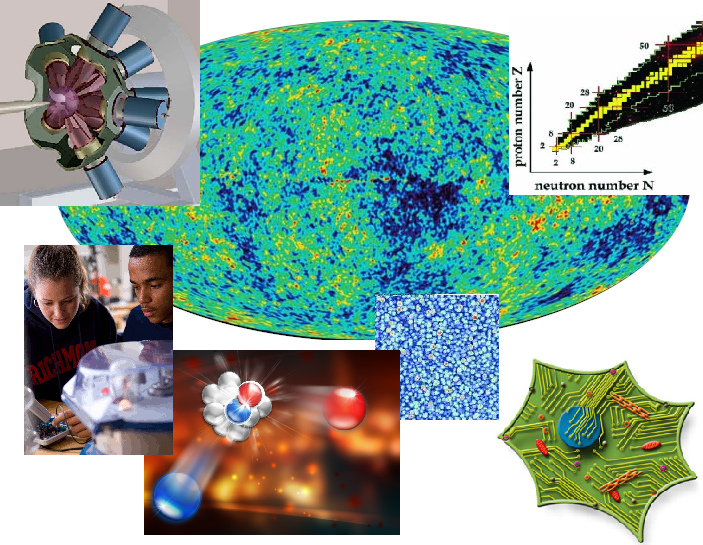Physics Research at the University of Richmond

The Physics Department is one of the most research-intensive departments at the University of Richmond. All faculty are supported by external grants
that provide funds for equipment, student stipends, and travel.
Nurturing the growth of new scientists pervades the curriculum from introductory courses to our Senior Seminar where students follow their own path
on a research project.
Undergraduates can participate in nearly ALL of our efforts.
Here we list the areas of active inquiry in Physics and the faculty leaders in those areas.
If you are thinking about doing research there is information
here on how to get involved.
There is more information here on why it is important
for your future.
- Experimental Nuclear and Particle Physics. Particles called quarks and gluons form the basis for the atoms, molecules, and atomic nuclei that make up our world. How these quarks and gluons actually combine to form that matter is still shrouded in mystery and remains one of the grand challenges in physics. We use the Thomas Jefferson National Accelerator Facility (TJNAF) to explore this new territory. The electron and photon beams at TJNAF illuminate the inside of the atomic nucleus so we can unravel how these building-blocks bind to each other to make the matter we see around us.
See Dr. Gilfoyle's webpage.
- Astrophysics and Cosmology. Our work is in the field of cosmology, the study of the structure, origin, and evolution of the universe on the very largest scales. We analyze and interpret measurements of the cosmic microwave background radiation, which is a relic of a time when the universe was only half a million years old (20,000 times younger than today).
See Dr. Bunn's webpage.
- Condensed matter and nano-physics. We focus is on the self-assembly in block copolymer systems, particularly in thin films. These systems can form two-dimensional periodic structures of cylindrical or spherical micro-domains, with typical periodicities of tens of nanometers. The length scales of these structures makes such systems important both as laboratories for nano-scale physics, and for their potential applications in nanotechnology.
See Dr. Trawick's webpage.
- Experimental Nuclear Structure Physics. The atomic nucleus lies at the heart of matter and at the core of stars. Consisting of between a few and a few hundred strongly-interacting fermions (the protons and neutrons) the atomic nucleus exhibits a wealth of different behaviors when excited. We strive to understand the interplay between the collective motion of many protons and neutrons together and single particle motions involving individual nucleons. Simple sounding questions such as ... What is the shape of a nucleus? Does this shape change as one makes a nucleus spin faster and faster? Do nuclei vibrate? Or rotate? See Dr. Beausang's webpage.
- Biological Physics. Biology is still an uncharted territory and open to new fundamental discoveries. Before Newton, the phenomena of mechanical motion were not understood in their simple fundamental form. Likewise in Molecular Biology we are in a pre-Newtonian time. A living organism functions through the interaction of thousands of genes; and these interactions are precisely regulated in time. The study of these interactions gave birth to the field of Systems Biology. See Dr. Lipan's webpage.
- Environmental Radiation. The world we live in is radioactive.
The environmental radiation laboratory in the physics department houses a suite of sensitive gamma and charged
particle detectors capable of detecting and quantifying these tiny amounts of radiation.
We have a variety of student-led projects including a collaborative project with Biology to examine the
environmental radiation content of sea-sponges.
See Dr. Beausang's webpage.
- Homeland Security. Since the terrorist attacks on 9/11 there has been an explosion of interest in ways that
science can make us more secure.
The Department has active work in science policy and stockpile stewardship (maintaining the reliability of our
nuclear weapons arsenal).
We are also developing an educational program for University students and first responders.
See Dr. Beausang's and
Dr. Gilfoyle's webpages.
- Physics Education. The Department has been at the forefront of new innovations in physics teaching for over a decade. In all our introductory courses, we emphasize small sections (a limit of 24 students in a class) and an active, hands-on, approach to learning physical law. Students simply learn better when they reveal nature's secrets for themselves instead of passively listening to lectures. This approach invigorates our upper-level courses where students can frequently work on individual projects including a final, capstone experience in our Senior Seminar.
See Dr. Gilfoyle's webpage.
Physics Department Home Page |
University Internal Home Page

